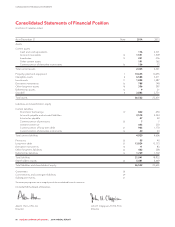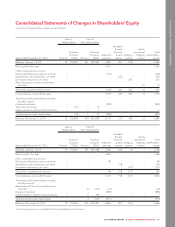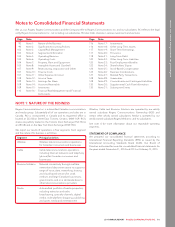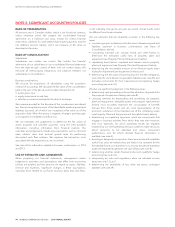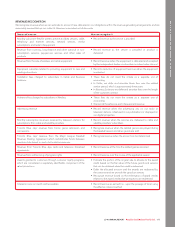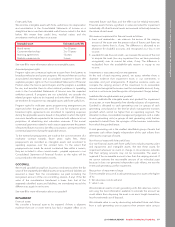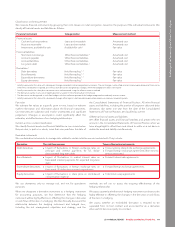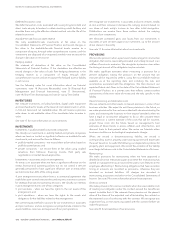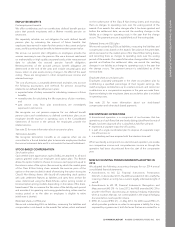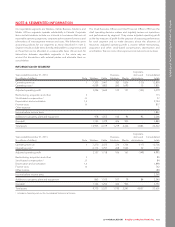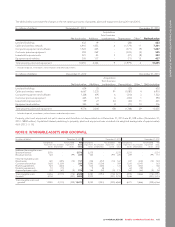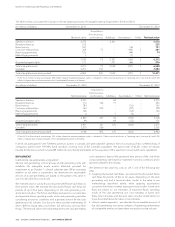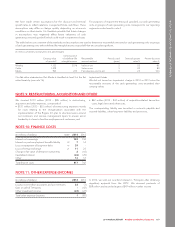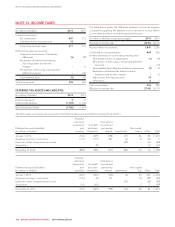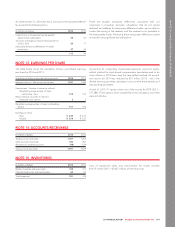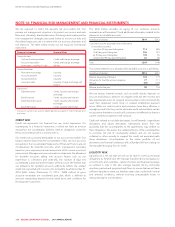Rogers 2014 Annual Report Download - page 104
Download and view the complete annual report
Please find page 104 of the 2014 Rogers annual report below. You can navigate through the pages in the report by either clicking on the pages listed below, or by using the keyword search tool below to find specific information within the annual report.NOTES TO CONSOLIDATED FINANCIAL STATEMENTS
Deferred transaction costs
We defer transaction costs associated with issuing long-term debt and
direct costs we pay to lenders to obtain revolving credit facilities, and
amortize them using the effective interest method over the life of the
related instrument.
Available-for-sale financial assets reserve
We carry available-for-sale investments at fair value on the
Consolidated Statements of Financial Position and record changes in
fair value in the available-for-sale financial assets reserve as a
component of equity, through other comprehensive income, until the
investments are disposed of or impaired, at which time we record the
change in fair value in net income.
Hedging reserve
We measure all derivatives at fair value on the Consolidated
Statements of Financial Position. If the derivatives are effective we
record changes in fair value of cash flow hedging derivatives in the
hedging reserve as a component of equity through other
comprehensive income until we recognize the hedged asset or liability
in net income.
See the following notes for more information about our financial
instruments: note 14 (Accounts Receivable), note 16 (Financial Risk
Management and Financial Instruments), note 17 (Investments),
note 19 (Short-Term Borrowings) and note 21 (Long-Term Debt).
INVENTORIES
We measure inventories, including handsets, digital cable equipment
and merchandise for resale, at the lower of cost (determined on a first-
in, first-out basis) and net realizable value. We will reverse a previous
write down to net realizable value if the inventories later increase in
value.
See note 15 for more information on our inventories.
INVESTMENTS
Investments in publicly traded and private companies
We classify our investments in publicly traded and private companies
where we have no control or significant influence as available-for-sale
investments, and account for them as follows:
• publicly traded companies – we record them at fair value based on
publicly quoted prices; and
• private companies – we record them at fair value using implied
valuations from follow-on financing rounds, third party sale
negotiations, or market-based approaches.
Investments in associates and joint arrangements
An entity is an associate when we have a significant influence on the
entity’s financial and operating policies but do not control it. We are
generally presumed to have significant influence over an entity when
we hold more than 20% of the voting power.
A joint arrangement exists when there is a contractual agreement that
establishes joint control over activities and requires unanimous consent
for strategic financial and operating decisions. We classify our interests
in joint arrangements into one of two categories:
• joint ventures – when we have the rights to the net assets of the
arrangement; and
•jointoperations–whenwehavetherightstotheassetsand
obligations for the liabilities related to the arrangement.
We use the equity method to account for our investments in associates
and joint ventures, and we recognize our proportionate interest in the
assets, liabilities, revenues and expenses of our joint operations.
We recognize our investments in associates and joint ventures initially
at cost, and then increase or decrease the carrying amounts based on
our share of each entity’s income or loss after initial recognition.
Distributions we receive from these entities reduce the carrying
amount of our investments.
We eliminate unrealized gains and losses from our investments in
associates or joint ventures against our investment, up to the amount
of our interest in the entity.
See note 17 for more information about our investments.
PROVISIONS
We record a provision when a past event creates a legal or constructive
obligation that can be reasonably estimated and is likely to result in an
outflow of economic resources. We recognize a provision even when
the timing or amount of the obligation may be uncertain.
We make significant estimates when measuring a provision for a
present obligation, basing the provision on the amount that we
estimate will be required to settle it, using the most reliable evidence
available as at the reporting date and including the risks and
uncertainties associated with the obligations. We then discount our
expected future cash flows to the date of the Consolidated Statement
of Financial Position at a pre-tax rate that reflects current market
assessments of the time value of money and the risks specific to the
liability.
Decommissioning and restoration costs
We use network and other assets on leased premises in some of our
business activities. We expect to exit these premises in the future, so
we make provisions for the costs associated with decommissioning the
assets and restoring the locations to their original standards when we
have a legal or constructive obligation to do so. We calculate these
costs based on a current estimate of the costs that will be incurred,
project those costs into the future based on management’s best
estimates of future trends in prices, inflation and other factors, and
discount them to their present value. We revise our forecasts when
business conditions or technological requirements change.
When we record a decommissioning liability, we record a
corresponding asset in property, plant and equipment and depreciate
the asset based on its useful life following our depreciation policies for
property, plant and equipment. We record the accretion of the liability
as a charge to finance costs in the Consolidated Statements of Income.
Restructuring
We make provisions for restructuring when we have approved a
detailed and formal restructuring plan and either the restructuring has
started or management has announced the plan’s main features to the
employees affected by it. Restructuring obligations that have uncertain
timing or amounts are recorded as provisions; otherwise they are
recorded as accrued liabilities. All charges are recorded in
restructuring, acquisition and other in the Consolidated Statements of
Income. See note 9 for more information about these expenses.
Onerous contracts
We make provisions for onerous contracts when the unavoidable costs
of meeting our obligation under the contract exceed the benefits we
expect to realize from it. We measure these provisions at the present
value of the lower of the expected cost of terminating the contract or
the expected cost of continuing with the contract. We recognize any
impairment loss on the assets associated with the contract before we
make the provision.
See note 20 for a breakdown of our provisions.
100 ROGERS COMMUNICATIONS INC. 2014 ANNUAL REPORT


